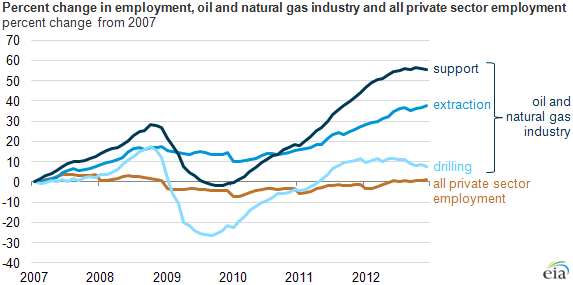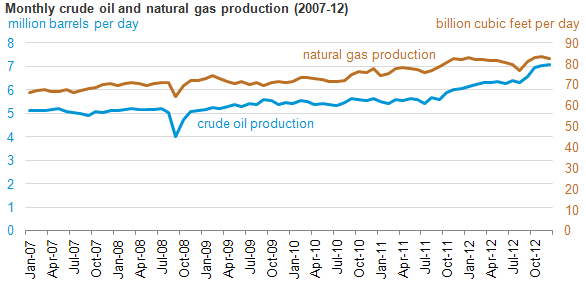
Oil and gas industry employment growing much faster than total private sector employment

Note: Total private sector employment is non-government employment, as derived from the Quarterly Census of Employment and Wages.
From the start of 2007 through the end of 2012, total U.S. private sector employment increased by more than one million jobs, about 1%. Over the same period, the oil and natural gas industry increased by more than 162,000 jobs, a 40% increase.
The Labor Department's Bureau of Labor Statistics (BLS) accounts for oil and natural gas industry employment in three categories: drilling, extraction, and support.
- Drilling involves any employment related to the spudding and drilling of wells, as well as reworking of wells, and accounted for more than 90,000 jobs by the end of 2012, an increase of 6,600 jobs since 2007.
- Extraction includes establishments primarily engaged in operating, developing, and producing oil and natural gas fields, including exploration and all production work up to the point of shipment from the producing property. Employment in the extraction category numbered more than 193,000 jobs by the end of 2012, 53,000 more jobs than in 2007.
- Support involves performing supporting activities for oil and natural gas operations, including exploration, excavation, well surveying, casing work, and well construction. Support is the largest oil and gas industry category, and employed more than 286,000 people by the end of 2012, up more than 102,000 jobs from 2007. (BLS considers support to be for the above activities, and does not include jobs created in other industries such as manufacturing, housing, retail, education, and food services.)
About half of the workers employed in crude oil and natural gas production are in the support category of oil and natural gas industry employment, and employment in this category accounted for the bulk of the increases seen in oil and gas industry employment. Combined, the three industry categories equal just one-half of one percent of total U.S. private sector employment.
Both the support and drilling industries were heavily affected by the recession, but these industries have recovered quickly, suffering only minor effects from the temporary moratorium on offshore drilling as a result of the Deepwater Horizon spill in 2010. Between January 2007 and December 2012, monthly crude oil production increased by 39%, and monthly natural gas production increased by 25% (see chart below). Employment in the oil and gas drilling, extraction, and support industries continues to contribute to overall private sector employment as the U.S. economy recovers from the 2007-09 recession.
Beyond within-sector employment, oil and gas industry activity also directly supports output and employment in other domestic sectors, such as suppliers of pipe, drilling equipment, and other drilling materials. In addition, as with other forms of economic activity, there are indirect employment effects stemming from purchases made by industry and employees spending of their incomes. Because employee expenditures are closely tied to their incomes, higher paying jobs, such as those in the oil and gas sector, tend to have larger indirect effects on output and employment than lower paying ones. A recent TIE article reviews the experience of North Dakota, which has seen significant gains in real gross domestic product per capita, coinciding with the development of the Bakken shale play.
